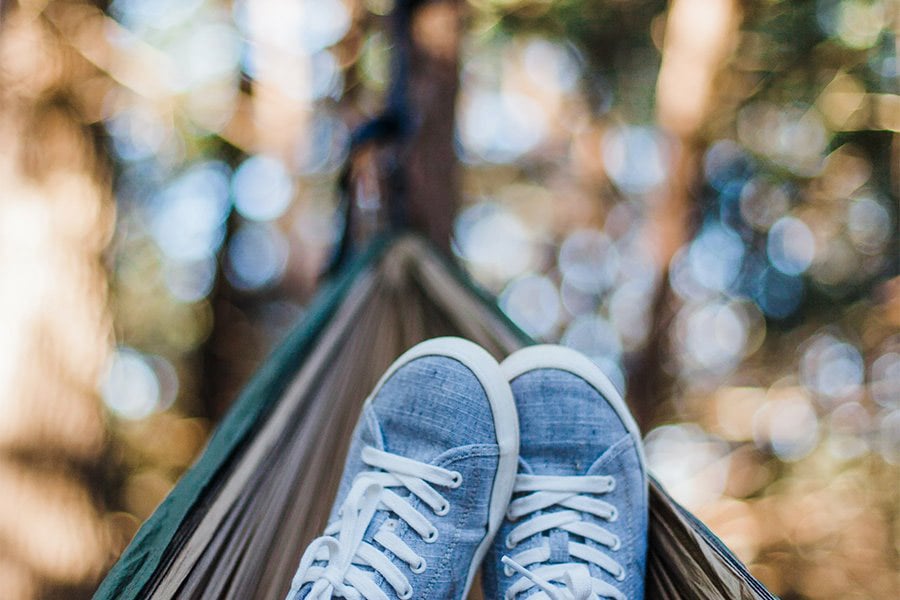Hammocking 101

When you think of hammocks, what comes to mind? Does the hammock have a white rope with wood bars at both ends to keep it open, and is strung between trees at a luxury resort in the Caribbean? Or maybe it's the thick cloth ones found in a friend’s backyard that are usually hard to get into and easy to flip. Perhaps you think of a pirate’s bed upon a ship? Fortunately, becoming a pirate or lugging around a big, heavy hammock with wood bars aren’t the only options for hammocking anymore. So let's take a closer look at the trend, the gear, and the purpose behind modern-day hammocking.
The Hammocking Trend
Gone are the days of stationary, hard-to-pack hammocks, as new lightweight and portable hammocks are gaining popularity with Millennials and Gen Zers. Best known as “hammocking” or by its slang term ‘mocking, it is simply the act of setting up your hammock, practically anywhere. A hammock is a perfect portable place to take a nap, read a book, socialize with friends, or even simply swinging for a little while.
So why is hammocking suddenly so popular? It can be a great social activity that can be done almost anywhere, at any distance. From a backyard to a local park to a 5-mile hike, lightweight hammocks are easy to transport, carry, set up and tear down, and being outdoors is proven to be beneficial to your health. You can hammock by yourself, share your hammock with someone else (if you have a double), or hammock near your friends. If you find tall, sturdy trees and are up for a challenge, you can even stack your hammocks with multiple people at various heights in the same tree. Being up in the trees has the added benefit of increased airflow while staying in the shade, even on a particularly hot day. Since you can control how taught the hammock is and how high off the ground it is, you can make it work for you. This isn’t just an activity for teenagers—it can be an activity for the whole family, from little kids to active grandparents!
The Gear
So you think hammocking sounds like fun but you’ve never been, so what do you actually need? For the most basic hammocking, you don’t need much—just a hammock, straps, and two sturdy posts, trees, or a hammock stand with 13 to 17 feet between them. The additional gear you might want or need will depend on what you plan to utilize your hammock for.
For example:
- If you live somewhere with pesky insects (pretty much anywhere in Minnesota), you can purchase special bug nets.
- If you want to camp overnight, you might want to look into a rain fly, camping pad, and a gear sling to keep your non-hammock items off the ground.
- If you get cold easily, bring a blanket or sweatshirt with you.
If you are just beginning, start with the basics and add from there as you start expanding your stay and distance.
When shopping for a hammock, there are a few things to note such as weight, size, type of strap, brands, and price point. Most hammocks used for ‘mocking weigh just a few pounds and pack down really small, making them ideal for short or long trips, backpacking, and storing at home. These lightweight hammocks can be found in many places, from our Travel Store at AAA Minneapolis to sports shops like REI, Scheels, Dick’s Sporting Goods, and more general stores like Walmart, Target, Amazon, and even Costco!
Sizing
There are two standard hammock sizes—single and double. The single usually holds around 200-300 pounds, has less fabric so it packs smaller, and is meant for just one “single” person. The double, on the other hand, generally holds closer to 400-500 pounds, still packs relatively small, and is usually a better bang for your buck. The double is designed to allow for two people to sit in the hammock together so there is significantly more material and space. Even when hammocking alone, many prefer a double to the single because the fabric can wrap closed easier—keeping cold air and bugs out. With a double, there is simply more space to sprawl out, be comfortable, or camp!
Straps
There are several different types of straps, so it's important to research what might work best for you before making your final purchase (although sometimes straps are included with the hammock). The original hammock straps were made out of rope and synthetic rope material and still work great today. The thick, long cords allow you to double them over to loop around a tree and then tie knots to adjust how taught the hammock is.
The other most common type of straps are referred to as woven, webbed, or manufactured straps. They are flat and wide, and structured more like a belt rather than a cord, which makes them gentler on trees. The manufactured straps are usually made with either a buckle or premade loops, and many people prefer the pre-set loops so they don't have to worry about tying knots or feeding the strap through a buckle. They are also the easiest straps to step on if you are trying to stack multiple hammocks in the same tree.
The difference in material ultimately comes down to preference as they all function well and work similarly.
Brand & Price Point
There are many brands of hammocks, but Eno and Kammock are the most recognizable, followed by brands like Sea to Summit, Madera, Bear Butt, etc. The main differences between brands include price point, material/weight, type of straps (if they are included), and most importantly: long-term durability. If you only plan to use it a couple of times a year in the backyard, a $20 or below hammock is a good starter hammock. However, a lower-priced hammock (like most other products) is more likely to wear out, fade, and get small tears than their more expensive counterparts from well-known brands.
If you are ready to head outside and start ‘mocking, or want to give one as a gift to a friend or family member, stop by the AAA Travel Store to check out our collection and save on your purchase with your member discount!





